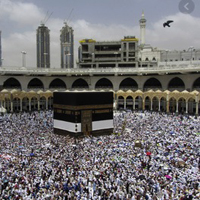Ethnicity is a major determinant of the pattern of dermatological diseases among pilgrims during the Hajj in 2019

Accepted: 21 January 2021
HTML: 0
All claims expressed in this article are solely those of the authors and do not necessarily represent those of their affiliated organizations, or those of the publisher, the editors and the reviewers. Any product that may be evaluated in this article or claim that may be made by its manufacturer is not guaranteed or endorsed by the publisher.
The authors aim to explore the pattern and demographics of dermatological disorders occurring during Hajj 2019. Clinical records from three major public healthcare facilities in Al-Madinah Al-Munawara were retrieved for the period July-August, 2019. Collected data included age, gender, nationality, and dermatological complaints. 550 records were retrieved. Patients were 282 (51.3%) males and 268 (48.7%) females with a mean age of 58.3±12.6 years. Most patients were Asians (n=320, 58.2%), and Africans (n=183, 33.3%). Accidents (n=226, 41.1%), and infections (148, 26.9%) were the most common complaints. Asians and Africans had significantly: more accidents and less infections (P=0.002, P=0.027 respectively). They were the only category affected by exacerbations of auto immune diseases. Asian and African pilgrims are mainly affected by traumatic dermatologic conditions. Preventive awareness programs should target these ethnicities to reduce their higher rates of accidents. Other ethnicities need programs that promote hygienic practices and target infections.
Gatrad AR, Sheikh A. Hajj: journey of a lifetime. BMJ 2005;331(7514):442.
Memish ZA, Stephens GM, Steffen R, Ahmed QA. Emergence of medicine for mass gatherings: lessons from the Hajj. Lancet Infect Dis 2012;12(1):56-65. DOI: https://doi.org/10.1016/S1473-3099(11)70337-1
S Shallcross LJ, Hayward AC, Johnson AM, Petersen I. Incidence and recurrence of boils and abscesses within the first year: a cohort study in UK primary care. Br J Gen Pract 2015;65(639):e668-76. DOI: https://doi.org/10.3399/bjgp15X686929
El-Bushra HE, Abodahish AA. Utilization of Primary Health Care Services during Hajj. Saudi Med J 1999;20(12):931-8.
Bakhsh AR, Sindy AI, Baljoon MJ, et al. Diseases pattern among patients attending Holy Mosque (Haram) Medical Centers during Hajj 1434 (2013).Saudi Med J 2015;36(8):962-966. DOI: https://doi.org/10.15537/smj.2015.8.12120
Fatani MI, Al-Afif KA, Hussain H. Pattern of skin diseases among pilgrims during Hajj season in Makkah, Saudi Arabia. Int J Dermatol 2000;39(7):493-6. DOI: https://doi.org/10.1046/j.1365-4362.2000.00009.x
Samdani AJ. Spectrum of skin disorders presenting to King Abdul Aziz Hospital during Hajj season-2000. J Ayub Med Coll Abbottabad 2004;16(3):10-3.
Lahita RG. The connective tissue diseases and the overall influence of gender. Int J Fertil Menopausal Stud 1996;41(2):156-65.
Aldossari M, Aljoudi A, Celentano D. Health issues in the Hajj pilgrimage: a literature review. East Mediterr Health J 2019;25(10):744-753. DOI: https://doi.org/10.26719/2019.25.10.744
Fatani MI, Bukhari SZ, Al-Afif KA, et al. Pyoderma among Hajj Pilgrims in Makkah. Saudi Med J 2002;23(7):782-5.
Rahman J, Thu M, Arshad N, Van der Putten M. Mass Gatherings and Public Health: Case Studies from the Hajj to Mecca. Ann Glob Health 2017;83(2):386-393 DOI: https://doi.org/10.1016/j.aogh.2016.12.001
Ichihashi M, Nagai H, Matsunaga K. Sunlight is an important causative factor of recurrent herpes simplex. Cutis. 2004;74(5 Suppl):14-8
James SF, Chahine EB, Sucher AJ, Hanna C. Shingrix: The New Adjuvanted Recombinant Herpes Zoster Vaccine. Ann Pharmacother 2018;52(7):673-680. DOI: https://doi.org/10.1177/1060028018758431
Muller LM, Gorter KJ, Hak E, et al. Increased risk of common infections in patients with type 1 and type 2 diabetes mellitus. Clin Infect Dis 2005;41(3):281-8. DOI: https://doi.org/10.1086/431587
Hoang VT, Gautret P. Infectious Diseases and Mass Gatherings. Curr Infect Dis Rep 2018;20(11):44. DOI: https://doi.org/10.1007/s11908-018-0650-9
Weinstein A, Berman B. Topical treatment of common superficial tinea infections. Am Fam Physician 2002;65(10):2095-102
Dar-Odeh NS, Gasim RA, Binsaad SM, et al. Use of natural remedies to treat oral diseases among female patients in Al Madinah, western Saudi Arabia. J Complement Integr Med 2019;16(3) DOI: https://doi.org/10.1515/jcim-2018-0032
McCray CJ, Agarwal SK. Stress and autoimmunity. Immunol Allergy Clin North Am 2011;31(1):1-18. DOI: https://doi.org/10.1016/j.iac.2010.09.004
Kridin K. Pemphigus group: overview, epidemiology, mortality, and comorbidities. Immunol Res 2018;66(2):255-270. DOI: https://doi.org/10.1007/s12026-018-8986-7
Al-Shayyab MH, Abu-Hammad OA, Al-Omiri MK, Dar-Odeh NS. Antifungal prescribing pattern and attitude towards the treatment of oral candidiasis among dentists in Jordan. Int Dent J 2015;65(4):216-26. DOI: https://doi.org/10.1111/idj.12173
PAGEPress has chosen to apply the Creative Commons Attribution NonCommercial 4.0 International License (CC BY-NC 4.0) to all manuscripts to be published.





 https://doi.org/10.4081/dr.2021.8934
https://doi.org/10.4081/dr.2021.8934



